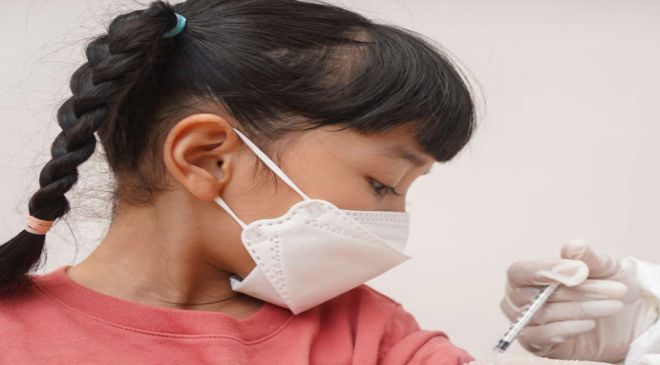(The Hill) – Childhood vaccine coverage across the U.S. has hit a measurable decline once again as health authorities hope to avert major surges in diseases such as RSV and COVID-19 this winter.
Also Read– Has COVID-19 become a summer illness? Cases and hospitalizations are on the rise again
Recent data from the Centers for Disease Control and Prevention (CDC) found that the rate of vaccinations against measles, mumps and rubella (MMR) for kindergarteners has fallen below the healthy target rate of 95 percent for the second year in a row to 93 percent.
“While this is a small decline, this is the lowest MMR rate reported in almost a decade and leaves approximately 250,000 school children unvaccinated and unprotected against measles, one of the world’s most contagious viruses,” KFF said in a recent brief.
It’s still too soon to fully ascertain the cause of this decline, though some factors relating to the COVID-19 pandemic may be at play.
“We do know that early in the pandemic some children missed some appointments or delayed some primary care, which could be contributing. And some kids may not have sort of caught up from those missed appointments,” said Elizabeth Williams, a co-author on the brief and senior policy analyst at KFF’s Program on Medicaid and the Uninsured.
Williams noted that vaccine hesitancy could also be a factor but reiterated that more time will be needed to truly pin down the cause.
A 2 percent drop is minor in effect — a “blip” as Williams called it — but still takes the U.S. further away from its Healthy People 2030 target of 95 percent, the coverage rate considered strong enough to establish herd immunity against community transmission.
Also Read– Bipartisan Senate bill aims to bolster drug supply chain by prioritizing U.S. manufacturing
Much of William’s report focused on MMR vaccinations, which are crucial due to how extremely contagious measles can be. According to the World Health Organization (WHO), one infected individual can spread the disease to nine out of 10 unvaccinated close contacts.
A recent outbreak of measles in central Ohio this past winter brought renewed attention to the risks of not completing MMR vaccinations. The CDC confirmed in a report this week that 94 percent of the 84 identified cases occurred in children under 5 years of age who were unvaccinated.
The CDC recommends that the first doses of MMR vaccines be administered between 12 and 15 months of age, and the second doses be administered between 4 and 6 years of age.
And as the new school year begins, other immunization concerns are arising.
The U.S. is in the midst of preparing for a fall COVID-19 vaccine campaign, the first to be conducted outside of a national public health emergency and the first meant to reflect a normal flu shot campaign.
The last update on vaccination rates from the CDC in May indicated less than a fifth of the U.S. had received the most recent booster shot. The U.S. population under the age of 5 had the lowest uptake of vaccine boosters in the final data set from the CDC, with only 18 percent having received the shot.
This will be the first campaign in which coronavirus vaccines will not be required to be free of charge, which could further deter potential recipients.
According to Sterling Ransone, a Virginia-based family physician and board chair of the American Academy of Family Physicians, the cost of immunization is “by far” the No. 1 reason why parents don’t get their children vaccinated.
Also Read– Health Experts Answer: Can Diabetics Eat Shrimp?
“You hear a lot about the misinformation and the ‘anti-vax’ folks who are out there, but they are a small minority of our patients in general,” Ransone said. “A large majority of the reason that our patients don’t get vaccinated is because of financial constraints.”
Vaccine fatigue is also to be expected following three years of a global pandemic, and it remains unclear how well-received a new updated shot will be.
Pfizer CEO Albert Bourla acknowledged this week there is a “higher level of uncertainty regarding the demand” for coronavirus vaccines this year. Bourla said he expected the new booster to be authorized by the Food and Drug Administration (FDA) this month.
The CDC this week also signed off on a preventive treatment for another respiratory virus that usually starts to rise in the fall: RSV. The monoclonal antibody known as Beyfortus was given the green light by the CDC on Thursday, meaning parents will soon have the means of protecting their children against the virus that caused thousands to be hospitalized last year.
The “daycare disease” is extremely common and typically goes away without the need for medication, but infants and toddlers are at a higher risk of developing severe cases. The CDC said it is working to have Beyfortus added to the federal Vaccines for Children program, which provides free vaccinations to children who may not get immunized otherwise due to an inability to pay.
Also Read– There are more health benefits to yoga than just being bendy
Heading into respiratory viral season and the new school year, experts stressed that it is key for parents to have conversations with trusted health care providers about their options for protection.
“It’s going to be important to sort of pull some of those levers that are specific to younger children, like finding those trusted sources and having discussions with primary care providers as we head into the fall,” Williams said.































